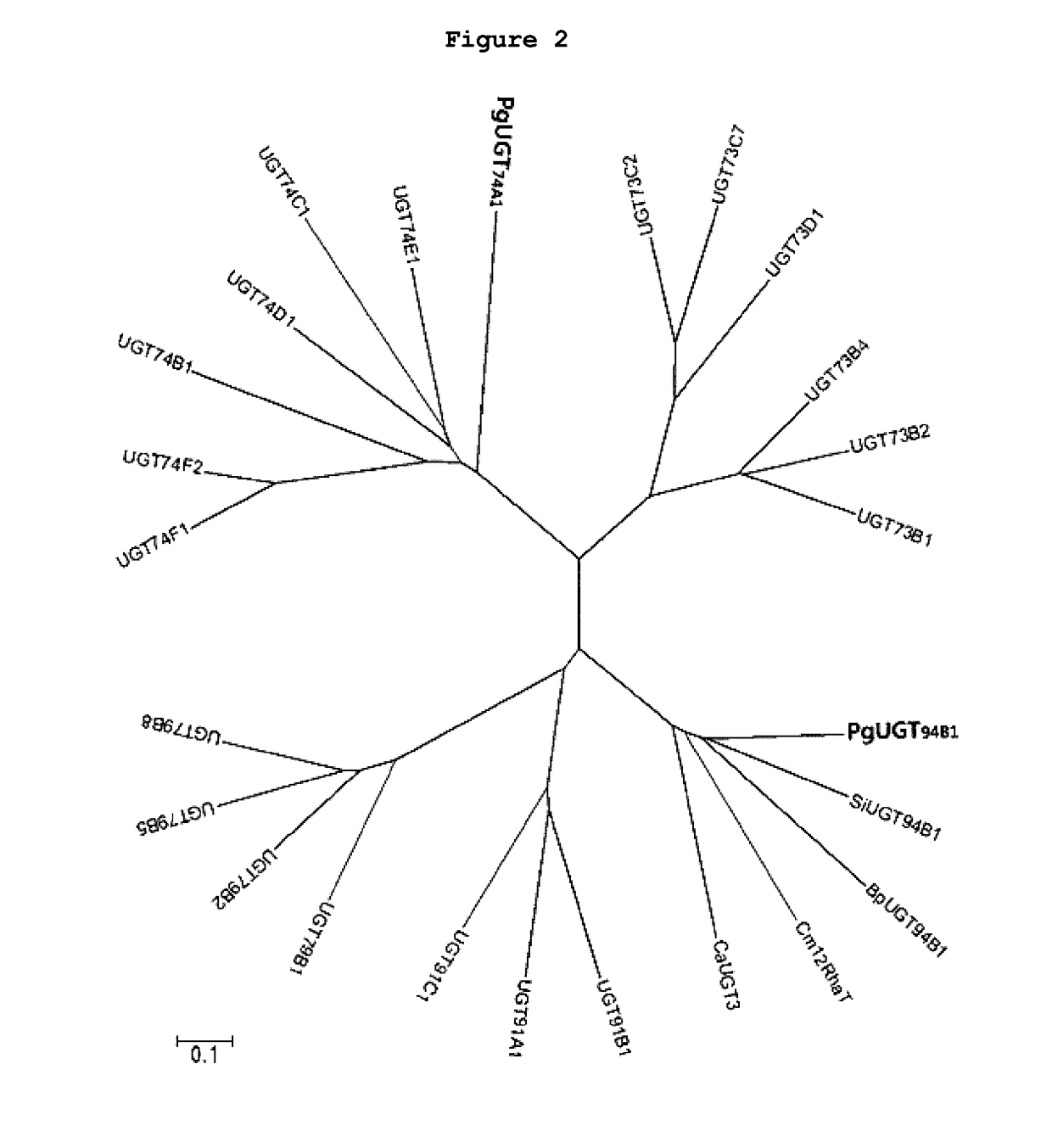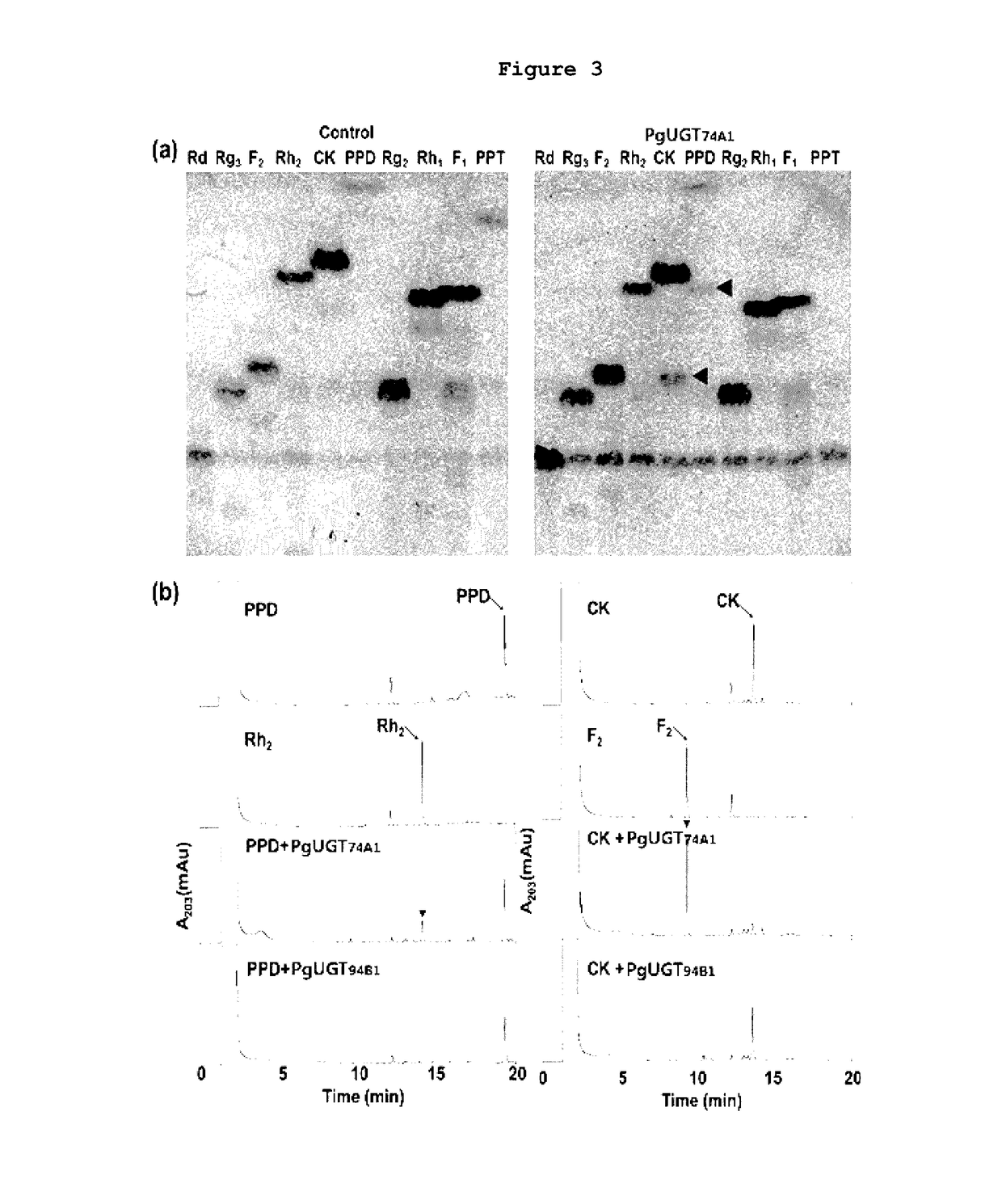UDP-glycosyltransferase derived from ginseng and use thereof
a technology of ginseng and udp, which is applied in the direction of transferases, peptide sources, biocides, etc., can solve the problems of major obstacles in investigating the efficacy of certain drugs
- Summary
- Abstract
- Description
- Claims
- Application Information
AI Technical Summary
Benefits of technology
Problems solved by technology
Method used
Image
Examples
example 1
Cloning and Purification of Ginseng UDP-Glycosyltransferase (PgUGT)
[0075]Two types of UGT genes identified from the ginseng EST library were cloned into a pGEX4T-1 vector using the primer sets listed in the following Table 1 (SEQ ID NOs. 5 and 6, SEQ ID NOs. 7 and 8), and designated as PgUGT74A1 and PgUGT94B1, respectively.
[0076]
TABLE 1SEQPrimerSequence (5′->3′)ID NOPgUGT74A1-BamHIAGGCATGGATCCCTGAGCAAAACTCACATTATGTTCATC5PgUGT74A1-EcoRIAGGCATGAATTCTCAGGAGGACACAAGCTTTGAAATGAACTC6PgUGT94B1-BamHIAGGCATGGATCCGATAACCAAAAAGGTAGAATCAGTATA7PgUGT94B1-EcoRIAGGCATGAATTCCTATTGTTCATCTTTCTTCTTCTTACAAAT8
[0077]The E. coli cells (E. coli BL21-CodonPlus (DE3)-RIL) transfected with the recombinant proteins, PgUGT74A1 and PgUGT94B1, were cultured in a LB medium supplemented with 50 μg / ml ampicillin and 34 μg / ml chloramphenicol. Then the proteins were purified from the cell culture.
[0078]The expression of the target gene was induced by using 0.1 mM IPTG. Then the cell pellet was isolated by centrifuging ...
example 2
[0079]A glycosyltransferase assay was performed in a reaction buffer (10 mM PBS buffer, pH 7) containing the purified PgUGT74A1 or PgUGT94B1 (30 μg), a ginsenoside compound (5 mM) and UDP-glucose (50 mM). For this assay, 10 different types of ginsenosides including PPD (Protopanaxadiol), PPT (Protopanaxatriol), Compound K (C-K), ginsenoside Rg3, Rh2, F2, Rd, Rg2, Rh1 and F1 were used, and the structures of the ginsenosides are shown in FIG. 1.
[0080]The reaction mixture was incubated at 35° C. for 12 hours, and then the products were analyzed by thin-layer chromatography (TLC) or high performance liquid chromatography (HPLC).
[0081]TLC analysis was performed using a mobile phase (acetone:methanol:DDW=65:35:10 vol / vol) and a 60F254 silica gel plate (Merck, Germany). The resolved product on the TLC plate was detected by spraying the plate with 10% (vol / vol) sulfuric acid (H2SO4) and heating it at 110° C. for 5 minutes.
[0082]HPLC analysis was performed using ODS (2) ...
example 3
RNA Isolation and Real-time PCR Analysis
[0084]Total RNA was isolated from the leaf or root of 15-month-old ginseng using a spectrum plant total RNA kit (Sigma-Aldrich). 200 μM methyl jasmonate (MeJA) was sprayed onto the leaves of ginseng everyday for a total of 5 days, and samples were collected on the 6th day. The 1 μg of total RNA was used for cDNA synthesis.
[0085]Expression levels of different genes were examined by a quantitative RT-PCR using the primer sets listed in the following Table 2, and the results were normalized to the expression level of tubulin.
[0086]
TABLE 2GeneSequence (5′->3′)SEQ ID NO.PgDS5′-AAATGAAGAAGGTGGTTGGG-3′95′-CTCTATGCAGAGGTGTCGGA-3′10PgPPDS5′-GCCAGAGGATCCAATCAACT-3′115′-TCTCCATCCTTCGGGAATAA-3′12PgPPTS5′-GATGTCCTGGAATGCAGCTA-3′135′-AGTGCTTGACTCGTGGTGTC-3′14PgUGT74A15′-TATCGAACCCGAACGTACAA-3′155′-GTCGAGTTCCAACCACAATG-3′16PgUGT94B15′-GACAGAGGATTGGTTGTGGA-3′175′-TCAAAGGCTGATCAAGATGC-3′18PgTubulin5′-GAAGGCTTTCTTGCATTGGT-3′195′-CCCAGATCGTCTTCTTCTCC-3′20
PUM
| Property | Measurement | Unit |
|---|---|---|
| pH | aaaaa | aaaaa |
| pore size | aaaaa | aaaaa |
| pH | aaaaa | aaaaa |
Abstract
Description
Claims
Application Information
 Login to View More
Login to View More - R&D
- Intellectual Property
- Life Sciences
- Materials
- Tech Scout
- Unparalleled Data Quality
- Higher Quality Content
- 60% Fewer Hallucinations
Browse by: Latest US Patents, China's latest patents, Technical Efficacy Thesaurus, Application Domain, Technology Topic, Popular Technical Reports.
© 2025 PatSnap. All rights reserved.Legal|Privacy policy|Modern Slavery Act Transparency Statement|Sitemap|About US| Contact US: help@patsnap.com



